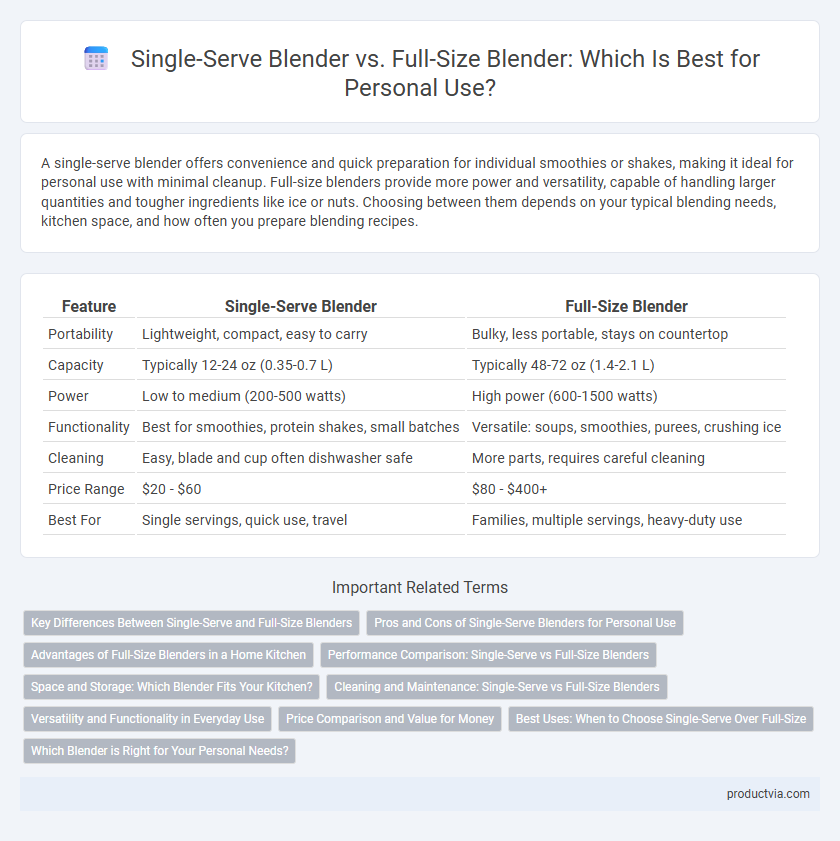A single-serve blender offers convenience and quick preparation for individual smoothies or shakes, making it ideal for personal use with minimal cleanup. Full-size blenders provide more power and versatility, capable of handling larger quantities and tougher ingredients like ice or nuts. Choosing between them depends on your typical blending needs, kitchen space, and how often you prepare blending recipes.
Table of Comparison
| Feature | Single-Serve Blender | Full-Size Blender |
|---|---|---|
| Portability | Lightweight, compact, easy to carry | Bulky, less portable, stays on countertop |
| Capacity | Typically 12-24 oz (0.35-0.7 L) | Typically 48-72 oz (1.4-2.1 L) |
| Power | Low to medium (200-500 watts) | High power (600-1500 watts) |
| Functionality | Best for smoothies, protein shakes, small batches | Versatile: soups, smoothies, purees, crushing ice |
| Cleaning | Easy, blade and cup often dishwasher safe | More parts, requires careful cleaning |
| Price Range | $20 - $60 | $80 - $400+ |
| Best For | Single servings, quick use, travel | Families, multiple servings, heavy-duty use |
Key Differences Between Single-Serve and Full-Size Blenders
Single-serve blenders typically feature smaller, portable designs with containers that double as travel cups, ideal for quick personal smoothies and easy cleanup. Full-size blenders offer higher wattage motors, larger capacity pitchers, and more versatile settings suitable for heavy-duty tasks like crushing ice, making soups, and preparing large batches. Choosing between them depends on user needs for portability, power, and volume capacity in blending applications.
Pros and Cons of Single-Serve Blenders for Personal Use
Single-serve blenders offer portability and convenience for personal use, enabling quick smoothies and easy cleanup with detachable cups. However, their smaller motor power and limited capacity may struggle with tough ingredients or larger batches compared to full-size blenders. Single-serve blenders excel in speed and space-saving design but sacrifice versatility and durability found in full-size alternatives.
Advantages of Full-Size Blenders in a Home Kitchen
Full-size blenders offer superior power and capacity, enabling efficient processing of larger batches and tougher ingredients such as nuts and ice, essential for family meals and complex recipes. Their versatile functions include pulsing, pureeing, and crushing, providing precision and consistency that single-serve blenders often lack. Durable construction and advanced motor technology in full-size blenders ensure long-term reliability and enhanced performance, making them ideal for diverse culinary tasks in a busy home kitchen.
Performance Comparison: Single-Serve vs Full-Size Blenders
Single-serve blenders excel in quick, convenient blending tasks with powerful motors designed for single portions, making them ideal for smoothies and small recipes. Full-size blenders offer higher wattage and larger capacity, delivering superior performance for tougher ingredients, multi-serve blends, and diverse culinary applications. Performance differences are evident in motor speed, blade durability, and noise level, with full-size models generally providing more consistent texture and blending power.
Space and Storage: Which Blender Fits Your Kitchen?
Single-serve blenders offer compact designs ideal for limited kitchen spaces and easy storage in small cabinets or countertops. Full-size blenders tend to require more counter space and larger storage areas but provide greater capacity for batch blending. Choosing between the two depends on your kitchen's available space and your blending volume needs.
Cleaning and Maintenance: Single-Serve vs Full-Size Blenders
Single-serve blenders typically feature detachable blending jars and fewer components, making them easier and quicker to clean compared to full-size blenders with bulky bases and multiple attachments. Full-size blenders often require thorough disassembly, with blades and seals needing careful washing to prevent buildup and ensure longevity. Regular maintenance of single-serve blenders usually involves rinsing or running the jar with soap and water, whereas full-size blenders benefit from periodic deep cleaning to maintain optimal performance.
Versatility and Functionality in Everyday Use
Single-serve blenders excel in quick, single-portion tasks like smoothies and protein shakes, offering compact design and easy cleanup. Full-size blenders provide greater versatility, handling a wider range of ingredients including tough vegetables, ice, and large batches for soups or sauces. Choosing between them depends on daily blending needs, with full-size blenders offering enhanced functionality for diverse kitchen tasks and single-serve models focusing on convenience and portability.
Price Comparison and Value for Money
Single-serve blenders typically cost between $20 and $60, offering affordability and convenience for personal use, while full-size blenders range from $100 to $500, providing more power and versatility. Single-serve blenders deliver value by catering to quick, individual portions without excess cleanup, ideal for smoothies or shakes. Full-size blenders justify their higher price with larger capacity, advanced blending features, and durability, benefiting users who prepare diverse recipes or larger quantities regularly.
Best Uses: When to Choose Single-Serve Over Full-Size
Single-serve blenders excel for quick, individual smoothies, protein shakes, and small portions, offering convenience and easy cleanup. They are ideal for busy lifestyles, limited kitchen space, or when preparing a single-serving recipe without leftovers. Full-size blenders suit larger batches, versatile blending tasks, and more powerful motor requirements for tougher ingredients.
Which Blender is Right for Your Personal Needs?
Single-serve blenders excel in quick, single-portion smoothies and easy cleanup, making them ideal for users with limited time or space. Full-size blenders offer powerful motors and larger capacities, suitable for versatile tasks like crushing ice, making soups, and batch preparation. Assessing personal usage frequency, recipe complexity, and counter space helps determine the best blender to meet individual lifestyle needs.
Single-serve blender vs full-size blender for personal use Infographic

 productvia.com
productvia.com